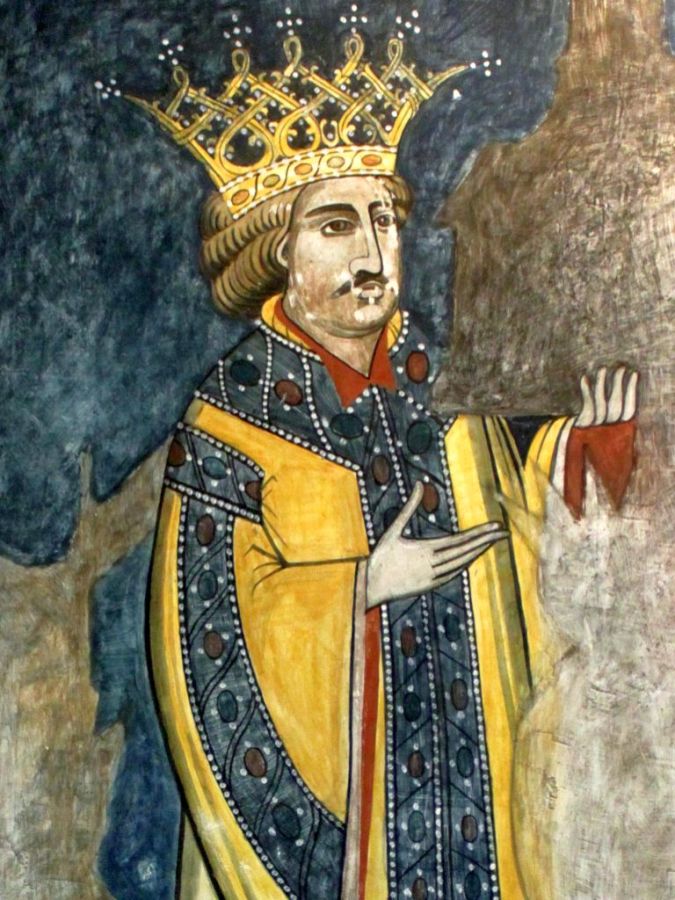Сорокская крепость – «ракушка» – единственная в своем роде. Построена она целиком из мела. Раньше ее называли генуэзской. Итальянское фортификационное искусство в те годы было на высоте, генуэзцы строили цитадели по всей Европе. И долгое время к генуэзским причислялась крепость в Сороках. Но Николай Булат, чье имя внесено в престижное британское издание «Сто интеллектуалов планеты», опроверг это утверждение. Историк по образованию, директор историко-краеведческого музея Сорок, автор солидной монографии по истории Сорок и сорокской крепости, он выдвинул, а потом и подтвердил свою версию строительства цитадели.

Николай Булат
Как рассказывает Николай Булат, по косвенным упоминаниям в средневековых документах, первая сорокская крепость была деревянной, и появилась примерно за 150 лет до появления знакомой нам каменной. Совершенствование артиллерии и появление огнестрельного оружия, свели на нет оборонительные возможности деревянных крепостей.

Петру Рареш
И в конце 30-х годов XVI века молдавский господарь Петру Рареш решает построить на месте деревянной каменную крепость. Она замышлялась как звено в цепи молдавских крепостей, протянувшихся вдоль Днестра. В Молдове не было нужных специалистов, и господарь Петру Рареш пишет два письма в трансильванскую Быстрицу, с просьбой прислать умелых строителей и опытных архитекторов.
Отозвались и те, и другие. И в 1543 году белые стены сорокской крепости с четырехугольными деревянными крышами над пятью башнями – четыре круглых и одна квадратная, уже поднимались на правом берегу Днестра. Какой архитектор строил крепость, неизвестно. Но явно европейский, и, скорее всего, британский – уж очень архитектурный стиль сорокской крепости похож на британскую замковую архитектуру. В XV-XVI веках на британских островах строили именно такие замки, небольшие и прочные.
Но почему Сорокская крепость – замок? Да потому что крепости – это не только прочные стены и башни, это еще система бастионов, валы и рвы, и центральная цитадель. И появились они в XVII веке, на сто лет позже самого замка. Это только по традиции замок в Сороках называют крепостью, – на самом деле это типичный замок западноевропейской архитектуры, в частности, британской: на британских островах сохранилось около ста замков, подобных сорокскому. Эти замки – маленькие, круглые, с очень толстыми крепкими стенами, местные жители до сих пор называют «ракушками».
Николай Булат указывает на поразительное сходство сорокской крепости и знаменитого английского замка Рестормел, построенного по типу «ракушки»: те же пропорции и почти те же размеры.
Рестормел
Диаметр замкового двора Рестормела – 34 метра. У сорокского – 30. Высота стен у обоих замков – 18 метров. А толщина сорокских стен – 3,5 метра. Снаряды, попадая в эти стены, отскакивали от нее как мячики, приводя в недоумение пушкарей. Молдавский господарь Дмитрий Кантемир, удивленный белым цветом стен сорокской цитадели, написал, в 1693 году, что сделаны они из кремния.

«Нет, они сделаны из мела, – говорит Николай Булат. – Как и кремний, это очень распространенный в этих местах минерал. Амортизирующие свойства мела удивительные. Вот и отскакивали ядра от сорокских крепостных стен». Из какого материала сделаны стены Рестормела, сорокский историк не знает, но британский замок более 200 лет лежит в руинах, а сорокская крепость для своих лет прекрасно сохранилась, хотя, кроме испытания временем, выдержала несколько жестоких осад и обстрелов орудиями.

Военная судьба замка закончилась в 1738 году. Тогда, во время русско-турецкой войны, он полностью сгорел и больше не восстанавливался. Крепость понемногу ветшала, пока в 1968 году не провели ее реставрацию. Внутренние помещения крепости в средневековье состояли из трех ярусов: первый – погреба с запасами пороха и продовольствия, второй – каменные казармы, третий – деревянная галерея. Во время реконструкции почти пятидесятилетней давности восстановили погреба с правой стороны от входа, казарму. Восстановление прошла и надвратная – главная башня, и над ней была построена крыша, чей вид не соответствовал историческому.



Но летом 2010 года Сорокская крепость попадает в список трех цитаделей, вместе с Сучавской и Хотинской, на восстановление которых выделяет деньги Евросоюз. Еврокомиссия, ознакомившись с объектами-кандидатами, решает отдать Сорокской крепости 2 млн. евро. И в 2013 году начинаются реставрационные работы. Над проектом восстановления работает архитектор Евгений Бызгу. На эти деньги укреплены крепостные стены, в квадратной, надвратной башне восстановлена крепостная часовня, над башнями возведены четырехугольные крыши с деревянными стропилами, крытые, как в старину, дранкой. Будет облагорожен парк, окружающий замок, и отремонтирована дорога, ведущая к крепости. Реконструкция завершилась к 19 мая, когда отмечается международный День музеев. В этот же день крепость впервые, после двух лет реставрации, снова открылась для посетителей.
Остается добавить, что сейчас завершен первый этап реставрации. В ходе последующих двух планируется восстановить все внутридворовые сооружения замка, в том числе, и деревянные галереи. Кроме прочего, в парке предполагается заново отстроить уничтоженную военную церковь Св. Георгия и восстановить небольшой форт, построенный поляками в конце XVII века.
Олег ТАЦЕНКО
Статья любезно предоставлена журналом Altitude — Air Moldova
English version: The second birth of Soroci fortress
The fortress in Soroci – “a shell” – is the one of a kind. It is constructed entirely from chalkstone. Earlier it was considered that it had the Genovese origin. In those years, the Italian art of fortification was at high ebb; and the Genoese erected the citadels and towers all over Europe. For the long period of time the fortress in Soroci was reckoned among them. However, Nikolai Bulat, whose name is included into the blue-ribbon British edition “One hundred intellectuals of the planet”, casted away this statement. Being a historian by education, the director of Soroci local history museum, as well as the author of the serious monograph on the history of Soroci and its fortress, he brought forward and later confirmed his own version of the citadel construction.

Nikolai Bulat narrates that in accordance with the circumstantial evidences in the medieval documents the first fortress in Soroci was a wooden one and was erected about 150 years prior to appearance of the stoned fortress that is so well-known to us. Perfection of artillery and invention of fire-arms brought to naught the defensive abilities of the wooden fortresses.
 And in the end of 30-s of XVI century the Moldovan hospodar (governor) Petru Raresh decided to construct a stoned citadel replacing a wooden one. It was planned that it would be a part of the range of the Moldovan fortresses along the Dniester River. Moldova did not have the specialists for this, and hospodar Petru Raresh wrote two letters in Transilvanian Bistritsa asking to send the skillful constructors and experienced architects.
And in the end of 30-s of XVI century the Moldovan hospodar (governor) Petru Raresh decided to construct a stoned citadel replacing a wooden one. It was planned that it would be a part of the range of the Moldovan fortresses along the Dniester River. Moldova did not have the specialists for this, and hospodar Petru Raresh wrote two letters in Transilvanian Bistritsa asking to send the skillful constructors and experienced architects.
Both responded. And in 1543 the white walls of Soroci fortress with quadrupole wooden roofs over five towers – four round and one square – were already dominating the right bank of Dniester. The name of the architect to construct the fortress is unknown. Still, it is clear that he was a European; and more than likely a British, since the architectural style of the fortress in Soroci reminds a lot the British castle architecture. In XV-XVI centuries, it was common for British islands to construct the castles like these – not large and solid. Still, why do we call the Soroci fortress – a castle? The reason is that the fortresses mean not only strong walls and towers, but they also include systems of bastions, embankments, fosses and a central citadel. The constructions like this appeared only in XVII century, in one hundred years after building the castle. And it is simply a tradition to call the castle in Soroci as a fortress – in fact, it is a typical castle in Western-European style and, in particular, in British one: at British islands, there survived about one hundred castles alike the one in Soroci. All these castles are small, roundish, and have very thick and solid walls – that is the reason why the locals call them “shells” until nowadays.
Restormel Сastle
Nikolai Bulat points out the amazing likeness of the Soroci fortress and the famous British Restormel Сastle that is constructed in style of a “shell” – the same proportions and almost the same size. The diameter of the yard in Restormel is 34 meters, while in Soroci – 30 meters. The height of the walls of both castles is 18 meters. The thickness of the walls in Soroci castle is 3.5 meters. The shells hitting these walls jumped off them perplexing the artillerists. The Moldovan hospodar Dmitrii Kantemir astonished with the white colour of the walls of Soroci citadel wrote in 1693 that they are made of silicon.

“No, they are erected from chalkstone, – Nikolay Bulat says. – Alike silicon, this mineral is widely spread in these places. Chalkstone has wonderful cushioning characteristics. This is why the shells jumped off the walls”. The historian from Soroci does not know what is the material the walls of Restormel are made from. However, it is already 200 years since the British castle is ruined, while the Soroci fortress is in the perfect condition for its ages, although besides the test of time it faced a number of cruel sieges and artillery shootings.

The military destiny of the castle ended up in 1738. At that time, during the Russian-Turkish war it burned away completely and was not reconstructed any more. The fortress deteriorated little by little, until it was restored in 1968. In medieval times, the inner premises of the fortress had three levels: the first one included basements with the reserves of gun powder and food; the second was used as the stone barracks and the third was made as the wooden gallery. In the course of the reconstruction that took place about 50 years ago the barracks and the basements on the right hand from the entrance were restored. The gate tower, which is the main one, also was subject to renovation. There was constructed the roof over it, although its appearance did not correspond to the historical one.



In summer 2010, the fortress in Soroci, along with the fortresses in Suceava and Hotin, got in the list of three citadels that were to be restored at the funds of the European Union. Having got acknowledged with the candidate objects, the European commission decided to allot 2 million Euro for the Soroci fortress. The restoration works started in 2013. The architect who works over the renovation project is Eugenii Bysgu. The funds are already invested into strengthening of the fortress walls; the gate church in the square tower is restored; and there are erected quadrupole roofs with wooden rafters covered, as it was in the old times, with wood lath. The park surrounding the castle will be also developed and the road leading to the fortress will be repaired. The reconstruction was finished by May 19 that is celebrated as the International Museum Day. And it was the first day when after two years of reconstruction the fortress was newly opened for the visitors.
It is only left to mention that the first stage of the renovation came to an end. In the course of two next stages it is intended to restore the facilities in the inner yard of the castle, including the wooden galleries. Besides, it is planned to construct anew the destroyed military church of St. Gheorghe and to restore the small fort built by the Poles in the end of XVII century.
Олег ТАЦЕНКО
The article was provided by the magazine Altitude – Air Moldova














Один комментарий
Вчера была в крепости ,просто ,случайно, всю жизнь хотела туда попасть ,а вчера представился случай ,я скажу вам,это было нечто! Прикоснувшись к истории прямо «руками» чувствуешь такое благоговение ,которое трудно описать ,понимаешь и восхищаешься тем колоссальным трудом ,проделанным реставраторами , и сам Николай Булат тебе ключами открывает Крепость ,берет плату (дико-мизерную) за посещение этого шедевра ,,,,,,, дорогие мои ,советую !!!